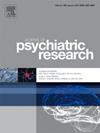揭示 SPIONs 在阿尔茨海默病治疗中的治疗潜力
IF 3.2
2区 医学
Q1 PSYCHIATRY
引用次数: 0
摘要
阿尔茨海默病(AD)是一种毁灭性的痴呆症,在全世界越来越常见。有毒的淀粉样蛋白-β(Aβ)聚集体是阿尔茨海默病发病和发展的主要原因。由于超顺磁性氧化铁纳米粒子(SPIONs)能够重定向 Aβ 纤维化过程并改善相关的大脑功能障碍,因此在过去十年中,超顺磁性氧化铁纳米粒子在老年痴呆症治疗领域受到了广泛关注。SPIONs在AD诊断中的潜在应用大大增加了人们的兴趣。此外,表面修饰的工程 SPIONs 还可作为药物载体,提高现有疗法的疗效。有关 SPIONs 在 AD 病理学中作用的各种临床前和临床研究都取得了令人鼓舞的结果。然而,由于其在生物环境中的物理化学特性(如尺寸、表面电荷和颗粒浓度),SPIONs 可能会对 AD 起到预防或加速作用。尽管SPIONs是AD的潜在治疗和诊断选择,但仍需做出巨大努力来克服不一致和安全问题。本综述评估了目前对各种 SPIONs 如何与 AD 模型相互作用的理解,并探讨了其疗效和安全性方面的差异。本文章由计算机程序翻译,如有差异,请以英文原文为准。
Unveiling the theranostic potential of SPIONs in Alzheimer's disease management
Alzheimer's disease (AD) is a devastating kind of dementia that is becoming more common worldwide. Toxic amyloid-beta (Aβ) aggregates are the primary cause of AD onset and development. Superparamagnetic iron oxide nanoparticles (SPIONs) have received a lot of interest in AD therapy over the last decade because of their ability to redirect the Aβ fibrillation process and improve associated brain dysfunction. The potential diagnostic application of SPIONs in AD has dramatically increased this interest. Furthermore, surface-modified engineered SPIONs function as drug carriers to improve the efficacy of current therapies. Various preclinical and clinical studies on the role of SPIONs in AD pathology have produced encouraging results. However, due to their physicochemical properties (e.g., size, surface charge, and particle concentration) in the biological milieu, SPIONs may play the role of a preventive or accelerative agent in AD. Even though SPIONs are potential therapeutic and diagnostic options in AD, significant efforts are still needed to overcome the inconsistencies and safety concerns. This review evaluated the current understanding of how various SPIONs interact with AD models and explored the discrepancies in their efficacy and safety.
求助全文
通过发布文献求助,成功后即可免费获取论文全文。
去求助
来源期刊

Journal of psychiatric research
医学-精神病学
CiteScore
7.30
自引率
2.10%
发文量
622
审稿时长
130 days
期刊介绍:
Founded in 1961 to report on the latest work in psychiatry and cognate disciplines, the Journal of Psychiatric Research is dedicated to innovative and timely studies of four important areas of research:
(1) clinical studies of all disciplines relating to psychiatric illness, as well as normal human behaviour, including biochemical, physiological, genetic, environmental, social, psychological and epidemiological factors;
(2) basic studies pertaining to psychiatry in such fields as neuropsychopharmacology, neuroendocrinology, electrophysiology, genetics, experimental psychology and epidemiology;
(3) the growing application of clinical laboratory techniques in psychiatry, including imagery and spectroscopy of the brain, molecular biology and computer sciences;
 求助内容:
求助内容: 应助结果提醒方式:
应助结果提醒方式:


